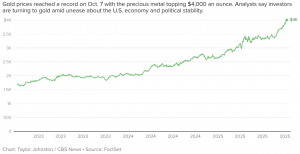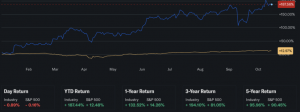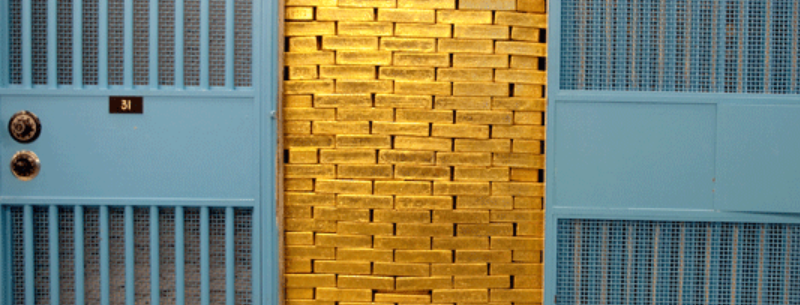Precious Metals Rally: Gold and Silver Surge Amid Uncertainty
Sara Kathuria
Staff Writer
Gold and silver are stealing the spotlight this week, climbing to record highs as investors brace for more economic turbulence. The rally comes at a time of global unease—an ongoing U.S. government shutdown, renewed trade tensions with China, and expectations of upcoming Federal Reserve rate cuts. Together, these forces have created a perfect storm that’s pushing investors toward “safe haven” assets, with gold and silver leading the charge.
What’s driving the surge?
Gold prices have surged to around $4,100 per ounce as of October 14, 2025, rising roughly 55% since the start of the year. Silver has gone even further, breaking past $53 per ounce on October 13, its first time crossing the $50 mark in more than four decades, and is now up over 75% year-to-date, according to data from LSEG and Goldman Sachs. Both metals have benefited from the Fed’s anticipated rate cuts, which make non-yielding assets more attractive, and from a wave of global uncertainty that’s sending traders scrambling for stability.
Adding to the rally is the ongoing government shutdown and President Donald Trump, whose newest comments announcing a 100% tariff on Chinese imports reignited trade war fears. The shutdown has stalled federal activity and delayed key data, shaking confidence in the economy’s direction. The tariff moves raises costs for U.S. companies and risks higher consumer prices, fueling inflation worries and fears of retaliation from China. With markets on edge and policy uncertainty rising, investors are turning to gold and silver as safer, more reliable stores of value.
Gold takes the lead
Gold’s rally this year has been anchored by central-bank demand, which provides a steady foundation even as markets fluctuate. Many governments have been adding to their reserves to protect against inflation, currency swings, and slowing global growth. That constant accumulation gives gold long-term stability and separates it from the short-term speculation driving other commodities. Its appeal also lies in its practicality. It’s scarce, easy to store, and universally accepted, making it the preferred reserve asset for both governments and major institutions.

Silver: The Wild Card
Silver’s surge has been sharper than gold’s, but it also carries more risk. The price jump has been fueled by strong investor demand and a shortage of supply in London, where global silver trading takes place. Inventories there have fallen to their lowest levels in years, creating a supply squeeze that pushed prices even higher.
Part of the rally also came from what traders call a “short squeeze.” When investors who bet that prices would fall were forced to buy silver back at higher prices, the sudden rush of buying made silver climb even faster.
Unlike gold, silver’s value depends partly on industrial demand. It is used in solar panels, electronics, and medical equipment, so when manufacturing slows, silver can drop quickly. The market for silver is also much smaller than gold’s, meaning even small changes in buying or selling can cause large price swings.

Analysts Weigh In
Experts say gold’s rise looks more stable, while silver’s momentum could fade faster. Economists at Goldman Sachs believe gold will stay strong because central banks keep buying it and investors expect interest rates to fall. Analysts at Bank of America also raised their forecast, saying gold could reach $5,000 per ounce by 2026 if inflation remains high and the U.S. dollar weakens.
Silver’s outlook is less certain. Goldman Sachs warns that because the silver market is much smaller than gold’s, prices can change quickly when investors pull back. Analysts at HSBC, a global financial firm based in London, expect silver to remain volatile, predicting it will average around $38 per ounce in 2025, which is far below its recent highs.
Most analysts agree that gold is the safer, longer-term investment, while silver offers bigger gains but greater risk. Both could benefit if economic uncertainty continues, but gold’s steady demand gives it a stronger base.
Contact Sara at kathursa@shu.edu

